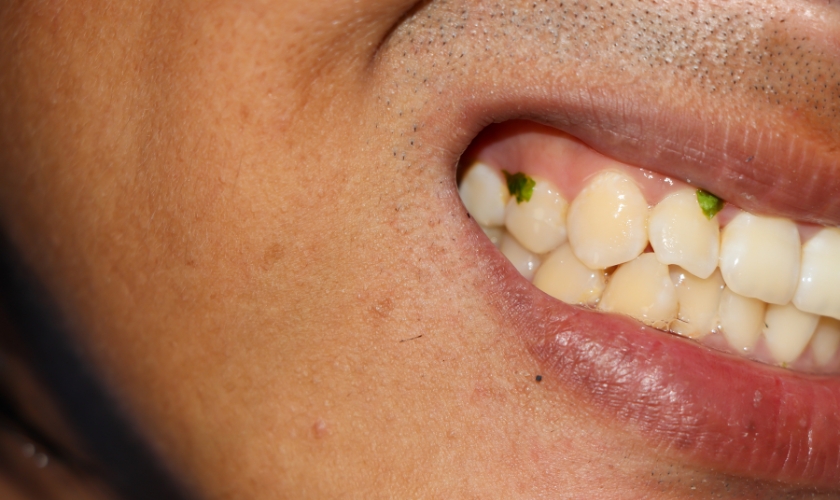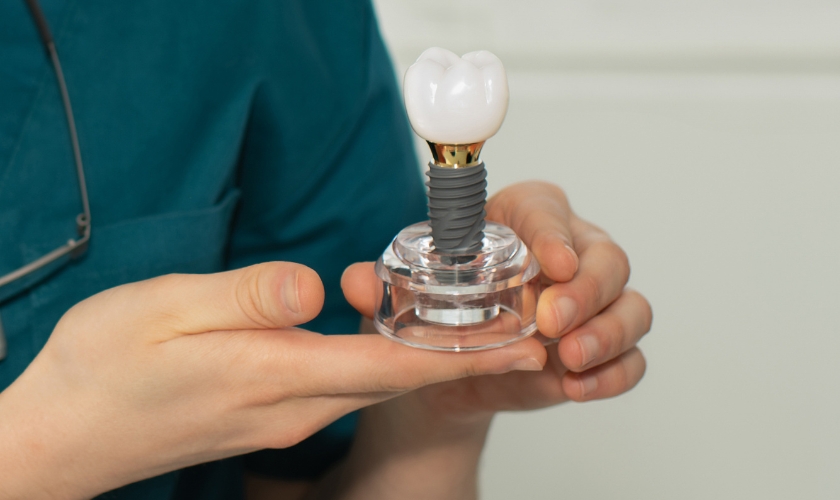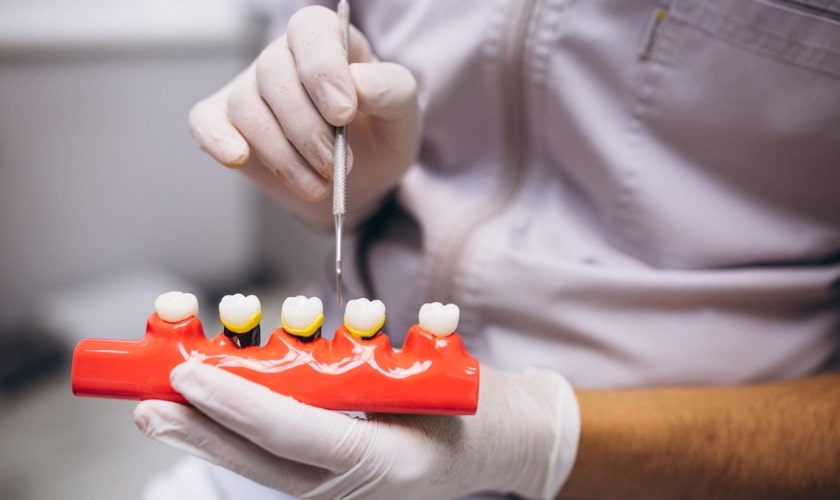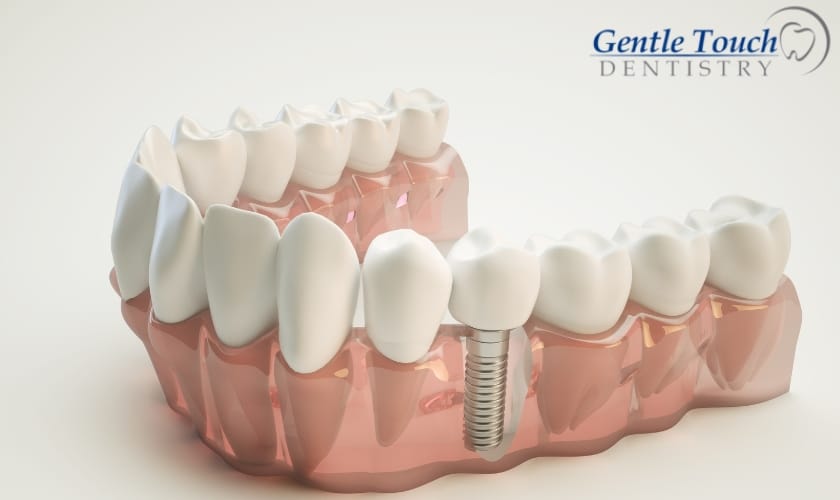
By Gentle Touch Dentistry Richardson
Dental implants in Richardson, TX are a popular and long-lasting solution for replacing missing teeth. They offer exceptional functionality and aesthetics, mimicking the look and feel of natural teeth. However, unlike natural teeth, dental implants don’t have the same support structure. This can sometimes lead to food particles getting trapped around the implant and gum tissue.
Here’s a breakdown of why food traps can occur around implants:
What are dental implants?
Dental implants are artificial tooth roots surgically placed in your jawbone. These implants act as anchors for crowns (caps) that are custom-made to resemble your natural teeth. Implants are known for their durability and stability, providing a natural-looking and functional replacement for missing teeth.
Why do food particles get trapped around implants?
While dental implants in Richardson, TX offer numerous benefits, there are slight anatomical differences compared to natural teeth that can cause food to get trapped:
- Difference between natural teeth and implants: Natural teeth have a periodontal ligament, a tissue that connects the tooth root to the jawbone. This ligament allows for slight movement and a tight seal between the tooth and gum. Dental implants, on the other hand, fuse directly with the jawbone through a process called osseointegration. While strong and stable, this doesn’t allow for the same flexibility as a natural tooth.
- Implant design and placement affecting food traps: The design and placement of the implant and crown can also influence food traps. For example, if the crown doesn’t perfectly match the contours of neighboring teeth, or if the implant placement leaves a small gap between the implant and gum, food particles can more easily become lodged in these areas.
Signs and Symptoms of Food Trapped Around Implants
Food particles trapped around dental implants can cause various issues if left unaddressed. Here are some signs and symptoms to watch out for:
- Difficulty flossing or brushing around implants: Food debris stuck between the implant and gum tissue can make it challenging to clean effectively with a toothbrush or floss.
- Redness, swelling, or bleeding gums: Inflamed gums around the implant, often accompanied by redness, swelling, or bleeding, can be a sign of irritation caused by trapped food particles and plaque buildup.
- Bad breath (halitosis): Persistent bad breath can be a symptom of food decomposition and bacterial growth around the implant.
- Loose feeling around the implant: In severe cases, long-term food impaction can contribute to bone loss around the implant, leading to a loose feeling.
- Pain or discomfort: Food lodged around the implant can cause discomfort or even pain, especially when chewing.
Effective Cleaning Techniques for Dental Implants
Maintaining excellent oral hygiene is vital for the longevity and health of your dental implants in Richardson, TX. Here are some effective cleaning techniques to remove food particles and prevent buildup:
Brushing Techniques for Implants
- Choosing the right toothbrush: A soft-bristled toothbrush is ideal for cleaning implants as it removes plaque and debris without damaging the implant surface or irritating the gums. Consider using an angled toothbrush to reach all surfaces around the implant more effectively.
- Brushing angles and motions for implants: Use a gentle brushing technique with short back-and-forth strokes at a 45-degree angle towards the implant. Brush the chewing surface, the front and back surfaces of the implant, and the gum line around the implant. It’s also important to brush your natural teeth thoroughly as well.
Flossing Around Implants
Flossing is essential for removing food particles trapped between the implant and neighboring teeth, where a toothbrush may not reach. Here’s how to floss effectively:
- Traditional floss vs. Implant-specific floss: While regular floss can be used, consider using implant-specific floss, often wider and coated to be gentler on the implant surface.
- Flossing techniques for optimal cleaning: Wrap a generous amount of floss around each middle finger. Gently guide the floss between the implant and the neighboring tooth using a back-and-forth sawing motion. Hug the curved surface of the implant and clean both sides of the tooth gap. Repeat for each implant and surrounding tooth.
Oral Irrigators: A Powerful Tool for Implant Care
An oral irrigator is a fantastic tool for flushing out food debris and plaque buildup around implants and under the gum line.
- Benefits of using an irrigator for implants: The pulsating water stream from an irrigator can effectively reach areas that are difficult to clean with a toothbrush or floss alone. This can be especially helpful for people with dexterity limitations.
- Choosing and using an oral irrigator effectively: Follow the manufacturer’s instructions for using your irrigator. Direct the water stream at a 45-degree angle towards the gum line around the implant and between teeth. Use a low-pressure setting to avoid gum irritation.
Interdental Picks and Brushes
Interdental picks and brushes can help remove stubborn food particles lodged between implants or between implants and natural teeth. Choose the size that fits comfortably between your teeth and use gentle back-and-forth motions to clean the area.
Additional Tips for Preventing Food Traps Around Implants
While proper cleaning techniques are crucial, here are some additional tips to minimize the chances of food getting trapped around your dental implants:
Maintaining a Healthy Diet
- Foods to avoid or limit: Sticky and fibrous foods like candies, dried fruits, and tough meats can be more challenging to remove from around implants. Limiting these foods can help reduce the risk of food traps.
- Importance of proper hydration: Staying hydrated by drinking plenty of water throughout the day helps to flush away food particles and maintain a healthy mouth environment.
Regular Dental Checkups and Cleanings
- Professional cleaning to remove stubborn plaque: Regular dental checkups and cleanings are essential for maintaining good oral health and preventing peri-implantitis (gum disease around implants). During these visits, your dentist in Richardson, TX can professionally remove any stubborn plaque or buildup that you might miss with your at-home routine.
- Importance of early detection of peri-implantitis: Early detection and treatment of peri-implantitis are crucial to prevent bone loss and potential implant failure. Regular dental visits allow your Richardson dentist to monitor the health of your implants and gums and intervene if any issues arise.
Keeping Your Implants Clean and Healthy
Dental implants in Richardson, TX are a remarkable advancement in tooth replacement, offering a stable and aesthetically pleasing solution for missing teeth. However, maintaining good oral hygiene is essential to prevent food traps and ensure the long-term health and success of your implants.
Here’s a quick recap of the importance of good oral hygiene for dental implants:
- Effective cleaning techniques: Brushing with the right technique, flossing with implant-specific floss or using an oral irrigator, and interdental cleaning tools ensure thorough removal of food particles and plaque buildup.
- Maintaining a healthy diet: Limiting sticky and fibrous foods and staying hydrated help reduce the risk of food traps.
- Regular dental checkups and cleanings: Professional cleanings remove stubborn plaque and allow for early detection of any potential problems.
By following these practices, you can enjoy a confident smile with healthy, clean implants for years to come. If you have any concerns about food getting trapped around your implants or experiencing any of the symptoms mentioned earlier, don’t hesitate to schedule an appointment with your dentist in Richardson, TX to discuss your specific situation and receive personalized advice.
Frequently Asked Questions
Can I use a waterpik with dental implants?
Yes, a Waterpik or other oral irrigator can be a very effective tool for cleaning around dental implants. In fact, studies have shown that Waterpiks can be more effective than traditional floss for removing plaque and debris around implants. Just remember to use it on a low-pressure setting and follow the manufacturer’s instructions.
Is flossing essential for implant care?
Flossing is an important part of implant care, but it doesn’t necessarily have to be traditional floss. You can use implant-specific floss, which is wider and gentler on the implant surface, or an interdental brush. The key is to find a method that effectively removes plaque and food particles between the implant and neighboring teeth.
What if I can’t seem to remove trapped food?
If you’re struggling to remove trapped food with your regular cleaning routine, don’t force it. Using excessive force can irritate the gums or damage the implant. Try using an interdental pick or a waterpik to dislodge the food particles. If the food remains stuck or you experience any pain or discomfort, consult your dentist as soon as possible.
How often should I get my implants checked by a dentist?
Generally, it’s recommended to schedule regular dental checkups and cleanings every six months. However, your dentist may recommend more frequent visits depending on your individual needs and risk factors for peri-implantitis.






